Louis SĂĽe on:
[Wikipedia]
[Google]
[Amazon]
Louis Süe (14 July 1875 – 7 August 1968) was a French
 Starting in 1903 SĂĽe and Paul Huillard collaborated in building artists' workshops and buildings in Paris on the Rue Cassini, Boulevard Raspail and Boulevard du Montparnasse.
In 1910 SĂĽe travelled with Paul Poiret to
Starting in 1903 SĂĽe and Paul Huillard collaborated in building artists' workshops and buildings in Paris on the Rue Cassini, Boulevard Raspail and Boulevard du Montparnasse.
In 1910 SĂĽe travelled with Paul Poiret to

painter
Painting is a Visual arts, visual art, which is characterized by the practice of applying paint, pigment, color or other medium to a solid surface (called "matrix" or "Support (art), support"). The medium is commonly applied to the base with ...
, architect
An architect is a person who plans, designs, and oversees the construction of buildings. To practice architecture means to provide services in connection with the design of buildings and the space within the site surrounding the buildings that h ...
, designer
A designer is a person who plans the form or structure of something before it is made, by preparing drawings or plans. In practice, anyone who creates tangible or intangible objects, products, processes, laws, games, graphics, services, or exper ...
and decorator. He and André Mare co-founded the ''Compagnie des arts français'', which produced Art Deco
Art Deco, short for the French (), is a style of visual arts, architecture, and product design that first Art Deco in Paris, appeared in Paris in the 1910s just before World War I and flourished in the United States and Europe during the 1920 ...
furniture and interior decorations for wealthy customers. He also designed buildings and interiors, including the interiors of two passenger liners.
Early years
Marie-Louis Süe was born on 14 July 1875 in Bordeaux. He was the grand nephew of the writerEugène Sue
Marie-Joseph "Eugène" Sue (; 26 January 18043 August 1857) was a French novelist. He was one of several authors who popularized the genre of the serial novel in France with his very popular and widely imitated '' The Mysteries of Paris'', whi ...
.
His father was a wine merchant.
After graduating from secondary school he entered the Collège Sainte-Barbe
The Collège Sainte-Barbe () is a former college in the 5th arrondissement of Paris, France.
The Collège Sainte-Barbe was founded in 1460 on Montagne Sainte-Geneviève ( Latin Quarter, Paris). It was until its closure in June 1999 the "oldest ...
in Paris to prepare for the ''École Polytechnique
(, ; also known as Polytechnique or l'X ) is a ''grande Ă©cole'' located in Palaiseau, France. It specializes in science and engineering and is a founding member of the Polytechnic Institute of Paris.
The school was founded in 1794 by mat ...
''.
However, in 1893 he left Sainte-Barbe and entered the ''École des Beaux-Arts
; ) refers to a number of influential art schools in France. The term is associated with the Beaux-Arts architecture, Beaux-Arts style in architecture and city planning that thrived in France and other countries during the late nineteenth centu ...
'' where he studied painting in the studio of Victor Laloux (1850–1937).
During this period he also explored architectural design, and was awarded medals for his work. He gained his diploma in 1901.
SĂĽe made friends at the ''Beaux-Arts'' with the painters Pierre Bonnard
Pierre Bonnard (; 3 October 186723 January 1947) was a French painter, illustrator and printmaker, known especially for the stylized decorative qualities of his paintings and his bold use of color. A founding member of the Post-Impressionist gr ...
, Roger de La Fresnaye, André Derain and André Dunoyer de Segonzac.
In 1902 the Salon des Indépendants
Salon may refer to:
Common meanings
* Beauty salon, a venue for cosmetic treatments
* French term for a drawing room
A drawing room is a room in a house where visitors may be entertained, and an alternative name for a living room. The name i ...
and the Salon d'Automne showed his work.
SĂĽe's work always combined an understanding and respect for traditional forms with a willingness to explore the new.
Pre-War
Vienna
Vienna ( ; ; ) is the capital city, capital, List of largest cities in Austria, most populous city, and one of Federal states of Austria, nine federal states of Austria. It is Austria's primate city, with just over two million inhabitants. ...
to visit the Wiener Werkstätte
The Wiener Werkstätte ("Vienna Workshop"), established in 1903 by the graphic designer and painter Koloman Moser, the architect Josef Hoffmann and the patron Fritz Waerndorfer, was a productive association in Vienna, Austria that brought to ...
.
SĂĽe was exposed to cubism around 1910, and this influenced his architectural designs.
He exhibited a complete room setting at the 1910 Salon d'Automne, and would participate in the Paris Salons through the rest of his career.
SĂĽe and Huillard ended their partnership in 1912.
Süe joined other artists to create ''L'Atalier Français'', a cooperative business that borrowed organizational idea from the Wiener Werkstätte. The members included Süe, Roger de La Fresnaye, André Groult, Gustave Louis Jaulmes (1873–1959), and the brothers André and Paul Vera. André Vera wrote a manifesto that defined the goal of the group as combining traditional and modern ideas to bring clarity, order and aesthetic unity to interior design.
SĂĽe helped decorate Groult's house.
During the war the Atelier was dissolved. SĂĽe was drafted into the army and served in the south of Greece.
Louis Süe, André Mare and Gustave Jaulmes collaborated in 1919 in decorating the victory festivals in Paris.
Compagnie des arts français
In 1919 Süe and André Mare founded the ''Compagnie des arts français'' (French Arts Company) and in 1921 published their first designs of furniture, wallpaper, tapestries, silverware and ceramics. The company employed many artists and craftsmen to meet the needs of their sophisticated and wealthy clientele for interior decoration. The Metropolitan Museum acquired examples of their furniture as early as 1923. TheirArt Deco
Art Deco, short for the French (), is a style of visual arts, architecture, and product design that first Art Deco in Paris, appeared in Paris in the 1910s just before World War I and flourished in the United States and Europe during the 1920 ...
works, typically with flower designs, were both elegant and practical.
SĂĽe and Mare decorated interiors such as the Polish Embassy in Paris and the home of Jean Patou.
In their joint work ''Architectures'' (1921) Sue and Mare asserted that Art Nouveau was based on a synthesis of fine and decorative arts.
Their commercial designs often had simplified forms with rich materials.
In 1922 SĂĽe designed the industrial town of Lens
A lens is a transmissive optical device that focuses or disperses a light beam by means of refraction. A simple lens consists of a single piece of transparent material, while a compound lens consists of several simple lenses (''elements'') ...
- MĂ©ricourt for the French Northern Railway company.
In 1922 the ''Compagnie des arts français'' obtained financial support from Gaston Monteux, owner of the Raoul shoe firm.
SĂĽe and Mare worked together again for the 1925 International Exposition of Modern Industrial and Decorative Arts in Paris, where they built a contemporary art museum and the Fountain pavilion on the Esplanade des Invalides.
They showed a luxurious room in the grand salon with furniture, carpet, wallpaper and decorations in new forms linked to traditional designs.
They also collaborated that year on the interior decoration of the '' SS ĂŽle de France''.
Louis SĂĽe, or SĂĽe at Mare, designed all the perfume bottles and boxes for Jean Patou.
They also designed bottles for other perfumers, including the bottle for "Le Dandy" of D'Orsay.
Monteux sold the ''Compagnie des arts français'' to the Galeries Lafayette department store in 1928.
The new owners brought in Jacques Adnet, a modernist designer, and Sue and Mare left the firm due to disagreement with Adnet.

Later career
After leaving the ''Compagnie des arts français'' Louis Süe worked as an independent architect-decorator, and designed buildings for various well-known figures. Between 1929 and 1931 he built a Basque villa in Ustaritz for Jean Patou. Between 1934 and 1937 he reconstructed forHelena Rubinstein
Helena Rubinstein (born Chaja Rubinstein; December 25, 1872 – April 1, 1965) was a Polish and American businesswoman, art collector, and philanthropist. A cosmetics entrepreneur, she was the founder and eponym of Helena Rubinstein Incorporate ...
a run-down building, the HĂ´tel Hesselin, on the Quai de BĂ©thune in Paris, converting it in an elegant and luxurious mansion.
He also landscaped Rubinstein's beauty institute on the Rue du Faubourg Saint-Honoré
The Rue du Faubourg Saint-Honoré () is a street located in the 8th arrondissement of Paris, France. Relatively narrow and nondescript, especially in comparison to the nearby Champs-Élysées, Avenue des Champs-Élysées, it is cited as being on ...
.
He entered the competition to camouflage the Trocadéro palace for the Exposition Internationale des Arts et Techniques dans la Vie Moderne
The ''Exposition Internationale des Arts et Techniques dans la Vie Moderne'' (International Exposition of Art and Technology in Modern Life) was held from 25 May to 25 November 1937 in Paris, France. Both the Palais de Chaillot, housing the Mu ...
of 1937, and collaborated with Jean and Édouard Niermans (sons of Édouard-Jean Niermans) in building the theater of the new palace.
Süe was treasurer of the '' Société des artistes décorateurs'' from 1936 to 1937.
In 1939 he was named president of the ''Société des artistes décorateurs''.
For its Salon he designed a street's decorations and the Helena Rubinstein and Louis SĂĽe booths.
He built the French Village for the 1939 New York World's Fair
The 1939 New York World's Fair (also known as the 1939–1940 New York World's Fair) was an world's fair, international exposition at Flushing Meadows–Corona Park in Queens, New York City, New York, United States. The fair included exhibitio ...
.
SĂĽe lived in Istanbul and lectured at the Institute of Fine Arts during World War II
World War II or the Second World War (1 September 1939 – 2 September 1945) was a World war, global conflict between two coalitions: the Allies of World War II, Allies and the Axis powers. World War II by country, Nearly all of the wo ...
(1939–45).
After the war he built an industrial town in Rupt-sur-Moselle, Vosges, the Museum of the Annunciation in Saint-Tropez, and many villas and private residences.
He also created theater sets and interior decorations, including the interior of the ''SS Jean-Mermoz'' in 1957.
Louis SĂĽe died in Paris on 7 August 1968.
SĂĽe had become a chevalier of the Legion of Honour
The National Order of the Legion of Honour ( ), formerly the Imperial Order of the Legion of Honour (), is the highest and most prestigious French national order of merit, both military and Civil society, civil. Currently consisting of five cl ...
in 1925, and was elected an officer in 1936.
Publications
* * * * * * * * * *References
Sources
* * * * * * *Further reading
*See also
*Art Deco in Paris
The Art Deco movement of architecture and design appeared in Paris in about 1910–12, and continued until the beginning of World War II in 1939. It took its name from the International Exhibition of Modern Decorative and Industrial Arts, Intern ...
{{DEFAULTSORT:Sue, Louis
1875 births
1968 deaths
20th-century French architects
French designers
Artists from Bordeaux
École des Beaux-Arts alumni